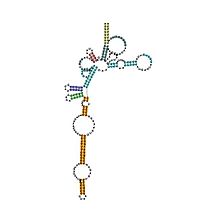RNase P
| Bacterial RNase P class A | |
|---|---|

Predicted secondary structure and sequence conservation of RNaseP_bact_a
|
|
| Identifiers | |
| Symbol | RNaseP_bact_a |
| Rfam | RF00010 |
| Other data | |
| RNA type | Gene; ribozyme |
| Domain(s) | Bacteria |
| GO | 0008033 0004526 0030680 |
| SO | 0000386 |
| Bacterial RNase P class B | |
|---|---|

Predicted secondary structure and sequence conservation of RNaseP_bact_b
|
|
| Identifiers | |
| Symbol | RNaseP_bact_b |
| Rfam | RF00011 |
| Other data | |
| RNA type | Gene; ribozyme |
| Domain(s) | Bacteria |
| GO | 0008033 0004526 0030680 |
| SO | 0000386 |
| Archaeal RNase P | |
|---|---|

Predicted secondary structure and sequence conservation of Archaeal RNase P
|
|
| Identifiers | |
| Symbol | RNaseP_arch |
| Rfam | RF00373 |
| Other data | |
| RNA type | Gene; ribozyme |
| Domain(s) | Archaea |
| GO | 0008033 0004526 0030680 |
| SO | 0000386 |
| Archaeal RNase P class T | |
|---|---|
| Identifiers | |
| Symbol | RNaseP-T |
| Rfam | RF02357 |
| Other data | |
| RNA type | Gene; ribozyme |
| Domain(s) | Archaea |
| GO | 0008033 0004526 0030680 |
| SO | 0000386 |
Ribonuclease P (EC 3.1.26.5, RNase P) is a type of ribonuclease which cleaves RNA. RNase P is unique from other RNases in that it is a ribozyme – a ribonucleic acid that acts as a catalyst in the same way that a protein based enzyme would. Its function is to cleave off an extra, or precursor, sequence of RNA on tRNA molecules. Further, RNase P is one of two known multiple turnover ribozymes in nature (the other being the ribosome), the discovery of which earned Sidney Altman and Thomas Cech the Nobel Prize in Chemistry in 1989: in the 1970s, Altman discovered the existence of precursor tRNA with flanking sequences and was the first to characterize RNase P and its activity in processing of the 5' leader sequence of precursor tRNA. Recent findings also reveal that RNase P has a new function. It has been shown that human nuclear RNase P is required for the normal and efficient transcription of various small noncoding RNAs, such as tRNA, 5S rRNA, SRP RNA and U6 snRNA genes, which are transcribed by RNA polymerase III, one of three major nuclear RNA polymerases in human cells.
Bacterial RNase P has two components: an RNA chain, called M1 RNA, and a polypeptide chain, or protein, called C5 protein.In vivo, both components are necessary for the ribozyme to function properly, but in vitro, the M1 RNA can act alone as a catalyst. The primary role of the C5 protein is to enhance the substrate binding affinity and the catalytic rate of the M1 RNA enzyme probably by increasing the metal ion affinity in the active site. The crystal structure of a bacterial RNase P holoenzyme with tRNA has been recently resolved, showing how the large, coaxially stacked helical domains of the RNase P RNA engage in shape selective recognition of the pre-tRNA target. This crystal structure confirms earlier models of substrate recognition and catalysis, identifies the location of the active site, and shows how the protein component increases RNase P functionality.
...
Wikipedia
